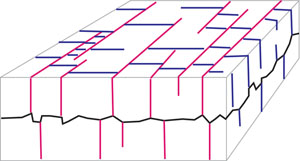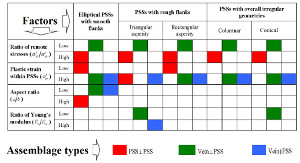| |||||||
|
|
|||||||
|
|
|||||||
| Mechanisms and Mechanics of Orthogonal PSS Sets | |||||||
|
Considering that pressure solution seams occur along the principal planes in pristine rock, it is not surprising that orthogonal pressure solution seams are common in nature (both in sets of two or three, all mutually at right angles (Agosta and Aydin, 2006 as idealized in Figure 1)). The mechanisms and mechanics of these anti-mode-I structural assemblages are similar to those of mode-I structures (Mardon, 1988) referred to under the link for orthogonal joints below.
However, there are complications due to the complexities associated with the process of pressure solution as indicated by a basic idealized configuration for Localized Volume Reduction Structure following Katsman et al. (2006). The number of different modes of structures involved for scenarios including pressure solution is very high as analyzed by Zhao and Aydin (2010; 2012) and summarized in Figure 2. In the table, the top row includes the shape factors (overall geometry - elliptical for this case, and asperities of triangular and rectangular). The columns include the remote stress ratio, plastic strain perpendicular to the structure, the aspect ratio, and the ratio of the Young's modulus inside the structure to that of the matrix. In this table, red marks highlight the factors or the combination of factors favoring orthogonal pressure solution seams and veins, and pressure solution seams and veins parallel to pressure solution seams. Within the present context, orthogonal pressure solution seam formation is enhanced by high stress ratio, low plastic strain, and high aspect ratio. Asperities of various shapes are also critical for stress magnifications at the flanks that initiate and drive both pressure solution seams and dilational cracks or veins. | |||||||
| Reference: |
|||||||
| Agosta, F., Aydin, A., 2006 Katsman, R., Aharonov, E., Scher, H., 2006 Mardon, D., 1988 Zhou, X., Aydin, A., 2010 Zhou, X., Aydin, A., 2012 |
|||||||
|
Readme | About Us | Acknowledgement | How to Cite | Terms of Use | Ⓒ Rock Fracture Knowledgebase |
|||||||

